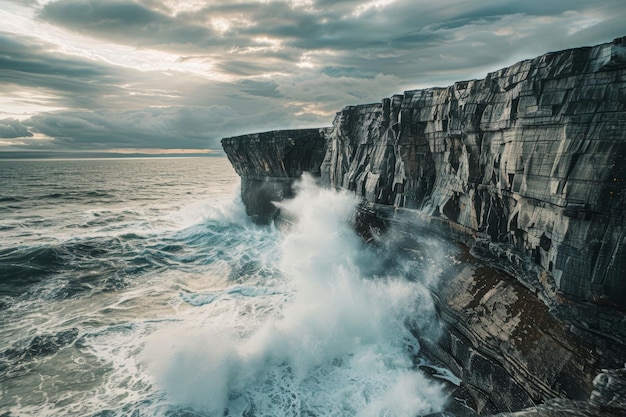Coastal Erosion And Flooding: The Impact Of Rising Sea Levels

Table of Contents
The Science Behind Rising Sea Levels
Rising sea levels are a direct consequence of global warming, primarily driven by human activities. This increase in sea level is a result of two main processes:
Thermal Expansion
As ocean temperatures rise due to increased greenhouse gas emissions, the water expands. This thermal expansion contributes significantly to the observed rise in sea level. Even a small increase in temperature can lead to a substantial increase in volume, particularly given the vastness of the world's oceans.
Melting Glaciers and Ice Sheets
The melting of glaciers and ice sheets in Greenland and Antarctica is another major contributor to rising sea levels. Data from NASA and the IPCC show an accelerating rate of melting, with significant consequences for global sea levels. The sheer volume of ice stored in these regions means even a small percentage of melting can have a dramatic impact.
- Positive Feedback Loop: Warming temperatures cause melting, which reduces the Earth's albedo (reflectivity), leading to further warming and increased melting – a dangerous positive feedback loop.
- Greenhouse Gases: The increasing concentration of greenhouse gases in the atmosphere, largely due to the burning of fossil fuels, traps heat and drives global warming.
The Impacts of Coastal Erosion
Coastal erosion, exacerbated by rising sea levels, is causing significant damage worldwide.
Loss of Land and Infrastructure
The relentless action of waves and currents, intensified by higher sea levels, leads to the erosion of coastlines. This results in the loss of beaches, valuable coastal habitats, homes, and vital infrastructure such as roads, ports, and power plants. The physical impact is devastating, reshaping coastlines and impacting livelihoods.
Economic Consequences
The economic consequences of coastal erosion are substantial. Loss of property values, reduced tourism revenue, and the high costs of mitigation and adaptation measures place a significant burden on coastal communities and national economies. The cost of repairing damage and building protective structures can be astronomical.
- Examples: The erosion of coastlines in Bangladesh, the Maldives, and parts of the US East Coast are prime examples of this destructive process.
- Displacement: Coastal erosion often leads to the displacement of communities, forcing people to abandon their homes and livelihoods.
- Cost of Protection: Seawalls, breakwaters, and other protective structures are expensive to build and maintain, representing a significant ongoing cost.
The Impacts of Coastal Flooding
Rising sea levels significantly increase the risk and severity of coastal flooding.
Increased Frequency and Severity of Floods
Higher sea levels exacerbate the impacts of storm surges and high tides, resulting in more frequent and severe coastal flooding events. Even minor increases in sea level can dramatically increase the extent and impact of flooding during storms.
Public Health Risks
Coastal flooding poses significant public health risks. These include waterborne diseases from contaminated floodwaters, injuries from debris and strong currents, and the significant mental health impacts associated with displacement and loss. Saltwater intrusion into freshwater sources further compounds the problem.
- Examples: Recent devastating floods in many coastal regions highlight the increasing threat of rising sea levels.
- Saltwater Intrusion: Saltwater intrusion contaminates freshwater supplies, impacting agriculture and drinking water sources.
- Emergency Response: Coastal flooding often overwhelms emergency response capabilities, making evacuations and rescue efforts challenging.
Mitigation and Adaptation Strategies
Addressing the challenges of coastal erosion and flooding requires a multi-pronged approach.
Reducing Greenhouse Gas Emissions
The most crucial step is to significantly reduce global greenhouse gas emissions to slow the rate of sea-level rise. This requires a global commitment to transitioning to cleaner energy sources and implementing sustainable practices.
Coastal Protection Measures
Various strategies can help protect coastlines, although each has its own limitations:
-
Seawalls: Provide a physical barrier but can cause erosion in adjacent areas.
-
Beach nourishment: Replenishing beaches with sand, but requires ongoing maintenance.
-
Managed retreat: Relocating communities and infrastructure away from vulnerable areas, a challenging but potentially necessary strategy.
-
Sustainable Coastal Management: Integrating ecological considerations into coastal protection strategies is essential for long-term success.
-
Community Involvement: Engaging local communities in planning and implementation is crucial for effective coastal management.
Conclusion
Coastal erosion and flooding, driven by rising sea levels, pose a severe threat to coastal communities and ecosystems globally. Understanding the science behind this phenomenon, recognizing its devastating impacts, and implementing effective mitigation and adaptation strategies are paramount. Reducing greenhouse gas emissions is crucial to slow the rate of sea-level rise, while coastal protection measures offer valuable, albeit localized, solutions. We must act decisively to address this urgent challenge. Learn more about coastal erosion and flooding and support initiatives aimed at protecting our coastlines from the devastating impacts of rising sea levels. Together, we can work towards a more resilient future for coastal communities.

Featured Posts
-
 Valentina Shevchenkos Fierce New Dragon Gear Design Details And Inspiration
May 11, 2025
Valentina Shevchenkos Fierce New Dragon Gear Design Details And Inspiration
May 11, 2025 -
 Ryan Reynolds Mntn Imminent Ipo Launch
May 11, 2025
Ryan Reynolds Mntn Imminent Ipo Launch
May 11, 2025 -
 The Meaning Behind Shane Lowrys Happiness For Rory Mc Ilroy
May 11, 2025
The Meaning Behind Shane Lowrys Happiness For Rory Mc Ilroy
May 11, 2025 -
 A Crazy Rich Asians Tv Series Is Coming What To Expect
May 11, 2025
A Crazy Rich Asians Tv Series Is Coming What To Expect
May 11, 2025 -
 Grand Slam Track A New League Aims To Revitalize Athletics
May 11, 2025
Grand Slam Track A New League Aims To Revitalize Athletics
May 11, 2025
